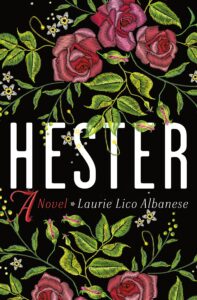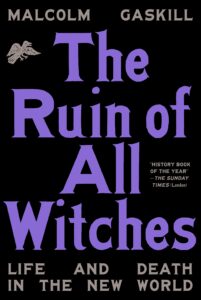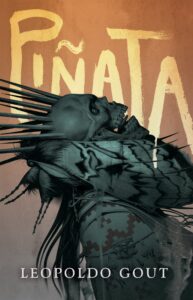Witches in novels, and in real life, are having a moment. While last summer was defined by the nap dress and Cottagecore, this year’s end to Roe V. Wade makes “goth witch” the only reasonable aesthetic to embrace. After all, the original witch crazes, according to Silvia Federici’s essential theory book Caliban and the Witch, were meant as methods of reproductive control—village women steeped in herblore understood how to terminate a pregnancy, and the capitalist need for new workers, soldiers, and prisoners, (or as Amy Comey-Barrett calls it, the “production of infants”) demands that women with enough knowledge to end a pregnancy be themselves terminated. Paradoxically, as our rights are taken away, witchcraft becomes ever more important for the power of magical thinking alone—sometimes, the only power in an increasingly disenfranchised nation.
There’s another reason witch books are popular right now: it’s the end of the world, environmentally speaking, and as our ability to change reality positively without magic diminishes, our need to embrace witchcraft correspondingly grows.
Witches also represent the spirit of female rebellion, or at the very least unapologetic female weirdness, explored by Mona Challet’s passionate work of nonfiction, In Defense of Witches: The Legacy of Witches and Why Women are Still on Trial. The trial aspect of the book is particularly relevant considering the growing backlash to #MeToo happening in the courts, not to mention the scores of women soon to be prosecuted for having or aiding an abortion based on their neighbor’s hearsay (basically what happened to like every cool woman in the 17th century).
While witch-themed releases have generally been restricted to Eurocentric Halloween reads in the past, this year also brings a diversification of magic and those who channel it. Desideria Mesa’s Bindle Punk Bruja takes us back to the 1920s with a Jazz-Age witch inspired by ancient Mexican folklore. Ciannon Smart’s Witches Steeped in Gold is set in a fantasy world based around Jamaican traditions. R.F. Kuang’s Babel, Or the Necessity of Violence: An Arcane History of the Oxford Translators’ Revolution takes medieval alchemy and applies it to a 19th century imperialist context in which language is the source of magic and also the source of iniquity.
Here’s another couple witch-themed releases: Camilla Bruce’s upcoming October release The Witch in the Well is unapologetic in its mingling of witchcraft and crime fiction, for a novel that does honor to the author’s own background running a magic shop. There’s also Big Bad, coming out this September and written by Lily Anderson, a Buffy super fan who thought that it would be fun if demons ran Sunnydale and had to band together to stop the Slayer, because, honestly, why not support the Big Bad for once?
So light your candles, burn your sage, put on your pentagram necklace, settle down next to your familiar (i.e., cat) and channel your rage via the year of the witch.
The following titles are all out in 2022 and 2023.

Brenda Lozano, Witches
Translated by Heather Cleary
(Catapult)
Brenda Lozano’s Witches, beautifully translated by Heather Cleary, follows reporter Zoe who meets the mystical Feliciana while investigating the murder of a curandera, Paloma. Feliciana learned all she knows from Paloma, the heir to a family tradition of magic and healing, and Zoe quickly becomes enraptured by her talents, and ready to understand the powers of women, the realities of femicide, and the oppression of the patriarchy in a new way.

Megan Giddings, The Women Could Fly
(Amistad)
Usually, when witches show up in a fiction, the history of persecuting women via witchcraft trials either gets glossed over or portrayed as being aimed at suppressing magic, rather than womanhood; in Megan Giddings’ The Women Could Fly, however, the misogyny is as real (more real) than the magic. In a dystopian version of America where witch-burnings carried over from Europe and accusations carried on long after Salem, women are “protected” from their potentially destructive natures by their male guardians and must get married at age 28 or register for recurring check-ins to ensure no manifestations of powers. As for the plot, Giddings’ heroine is contemplating the lack of choices in her future while fulfilling a quest for her long-missing mother, a woman who never believed in magic yet was suspected of witchcraft all the same.

Camilla Bruce, The Witch in the Well
(Tor)
Camilla Bruce owns a magic shop! No, seriously! And since she’s apparently not kept busy enough writing about 19th century serial killers (a common occurrence in her work) or selling herbs and tinctures, she also wrote a book about witches. In The Witch in the Well, two former friends are brought together once more, this time by competition, as they both find themselves drawn towards researching their small town’s most infamous legend—an innocent woman put to death for witchcraft and supposedly seeking vengeance. Will life imitate historical research? Will the witch return to haunt the town? And most importantly, will the protagonists rekindle their friendship in time to save each other from certain doom?

Lily Anderson, Big Bad
(Hyperion Avenue)
The Buffyverse is back! But this time, with one major twist: Sunnydale is now Demondale, a town where all the Buffy villains coexist in harmony under a permanent night sky. That is, until the Slayer gets transported from her dimension into theirs, and decides she has to destroy their entire world in order to get back to hers. Andrew, Jonathan, Anya, Angel, Faith, the Mayor, and the First Evil—they’ve all got to band together and defeat the slayer, or face the eradication of their own existence and that of everyone they love (or, you know, wanted to murder eventually). Lily Anderson, a self-described superfan of the Buffy franchise, delivers a loving tribute and delightful twist on the characters we all know and love.

Isabel Cañas, The Hacienda
(Berkley)
Isabel Cañas takes the gothic novel to the haciendas, just as Sylvia Moreno-Garcia’s Mexican Gothic took on the history of silver mining and imperialism. In The Hacienda, set just after the Mexican War for Independence, heroine Beatriz has been dispossessed of her family fortune after her father’s fall from political grace and subsequent execution. She finds a husband she feels will elevate her status and protect her mother from persecution, but strange happenings at her new estate and rumors of hauntings threaten to derail her new life, and a sexy local priest who moonlights as a witch is her only hope of survival. Lush, beautiful, and completely deserving of the comparisons to Rebecca, The Hacienda is essential reading in the gothic revival.

Desideria Mesa, Bindle Punk Bruja
(Harper Voyager)
Bindle Punk Bruja is as cool as its title, featuring a fast-talking flapper who runs a gin joint with the best jazz band in town, and keeps her bar safe from interference with earth magic learned from her Mexican mother. Mesa’s heroine also dabbles in sex magic, dropping each man as they get too attached, but as the silky smooth plot of BPB progresses, finds herself falling for a tattooed piano player with ties to Al Capone. Oh, and she’s involved in a gang war, while trying to keep her Mexican heritage a secret and use a sham marriage to secure a business loan. BPB is full of the spirit of the Jazz Age told from a rare and adventurous perceptive.

Laurie Lico Albanese, Hester
(St Martin’s Press)
Laurie Lico Abanese’s Hester is a beautifully imagined historical origin story for Nathaniel Hawthorne’s Scarlet Letter, following a Scottish immigrant dressmaker to the New England colonies whose friendship with Nate Hawthorne is the subject of some scandal about town. Albanese’s heroine is a proud descendent of a woman accused of witchcraft who evades her captors and births a strong line of take-no-prisoners women. Perfect for those who understand that any work that explores the pernicious accumulation of small town nastiness is basically just a psychological thriller anyway.

Kirstin Miller, The Change
(William Morrow)
The Change refers to that special time in a woman’s life when she begins to develop…magical powers, in this universe! That menopause comes with magic is now in my headcannon of reality. This better happen to me when I’m 50. In Kristin Miller’s atmospheric and lush novel, three women who couldn’t be more different join together after each discovering that their midlife bodies come with superhero powers. 2022 so far feels like the Year Everyone Discovers Their Inner Witch, so if you’ve been wearing a lot of black lace or spending a ton of time in your garden, you know this book’s for you.

Malcolm Gaskill, The Ruin of All Witches: Life and Death in the New World
(Knopf)
It’s been a great year for witch fiction, both for novels featuring powerful feminist magic and for history books exposing the intense misogyny behind the original witch trials. Gaskill’s The Ruin of All Witches is, of, course, the latter, as we learn of an obscure mid-17th century witch trial in Connecticut with vast implications for the present day. Gaskill paints a claustrophobic portrait of a suspicious, insular, and deeply competitive community ready to turn on each other just as quickly as one could shout “She curdled my milk!”.

Jennifer Givhan, River Woman, River Demon
(Blackstone)
“A psychological thriller that weaves together the threads of folk magick with personal and cultural empowerment” is the publisher’s description of this one, and damn if that doesn’t sound good.

Mona Chollet, In Defense of Witches: The Legacy of the Witch Hunts and Why Women Are Still on Trial
Translated by Sophie R. Lewis
(St. Martin’s Press)
This book looks so cool! And it’s not just cause of that perfect use of melodramatic purple on the cover. First of all, let’s just take a moment to celebrate the rarity of a work of nonfiction by a woman getting translated into English, because that doesn’t happen all that often. Plus, it’s about witches. And not only the history of witch burnings and what they meant for the persecution of difficult women, but how those same trends of ostracization and punishment are played out today. Ooh and there’s an intro from Carmen Maria Machado, which really clinches this one as a must-read.

Sara A. Mueller, The Bone Orchard
(Tor)
The visual creativity of The Bone Orchard is stunning. Charm, a powerful witch and mistress to the kingdom’s aged emperor, spends her days imprisoned in luxury, creating bone ghost simulacra of herself at different ages in life. Together, the bone ghosts serve the refined clients of Charm’s tasteful bordello, and when Charm’s emperor is murdered, she follows his last instructions: to find who has killed him, and to send his dangerous sons far from the throne.
And some for next year…

Leopoldo Gout, Piñata
(Tor Nightfire)
This stunningly crafted possession novel is rooted in Aztec history and Nahua religious practice, with an ancient Aztec vessel as the conduit for a powerful spirit seeking to avenge the victims of colonialism. Piñata follows an architect and her two daughters, first in Mexico City, then in New York City, pursued by the spirit all the while, as Gout examines the classic possession tale—an adolescent girl, given powers through her liminal state—and reframes it as a response to racism and the erasure of history and culture.

V. Castro, The Haunting of Alejandra
(Del Rey)
V. Castro’s heroine is haunted by the spirit of La Llorena—or, at least, an ancient evil that has found a way to embody a folk legend. She must go to a curandera and process her personal and generational trauma before she can even hope to be free of the demon possessing her, in what also functions as a perfect metaphor for clearing the fog of depression and seeing the societal structures and history that contribute to our present-day malaise.




















